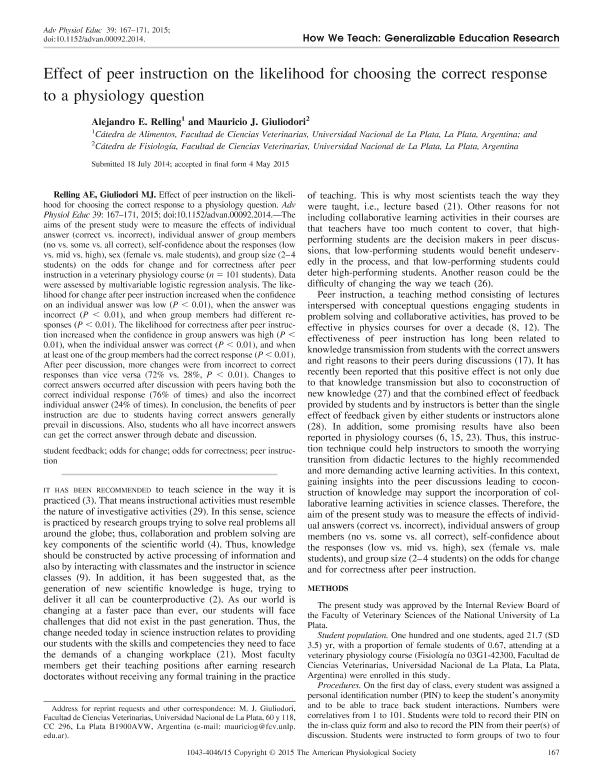Artículo
Effect of peer instruction on the likelihood for choosing the correct response to a physiology question
Fecha de publicación:
09/2015
Editorial:
American Physiological Society
Revista:
Advances In Physiology Education
ISSN:
1043-4046
e-ISSN:
1522-1229
Idioma:
Inglés
Tipo de recurso:
Artículo publicado
Clasificación temática:
Resumen
The aims of the present study were to measure the effects of individual answer (correct vs. incorrect), individual answer of group members (no vs. some vs. all correct), self-confidence about the responses (low vs. mid vs. high), sex (female vs. male students), and group size (2-4 students) on the odds for change and for correctness after peer instruction in a veterinary physiology course (n = 101 students). Data were assessed by multivariable logistic regression analysis. The likelihood for change after peer instruction increased when the confidence on an individual answer was low (P < 0.01), when the answer was incorrect (P < 0.01), and when group members had different responses (P < 0.01). The likelihood for correctness after peer instruction increased when the confidence in group answers was high (P < 0.01), when the individual answer was correct (P < 0.01), and when at least one of the group members had the correct response (P < 0.01). After peer discussion, more changes were from incorrect to correct responses than vice versa (72% vs. 28%, P < 0.01). Changes to correct answers occurred after discussion with peers having both the correct individual response (76% of times) and also the incorrect individual answer (24% of times). In conclusion, the benefits of peer instruction are due to students having correct answers generally prevail in discussions. Also, students who all have incorrect answers can get the correct answer through debate and discussion.
Palabras clave:
Student Feedback
,
Odds for Correctness
,
Odds for Change
,
Peer Instruction
Archivos asociados
Licencia
Identificadores
Colecciones
Articulos(IGEVET)
Articulos de INST.DE GENETICA VET ING FERNANDO NOEL DULOUT
Articulos de INST.DE GENETICA VET ING FERNANDO NOEL DULOUT
Citación
Relling, Alejandro Enrique; Giuliodori, Mauricio Javier; Effect of peer instruction on the likelihood for choosing the correct response to a physiology question; American Physiological Society; Advances In Physiology Education; 39; 3; 9-2015; 167-171
Compartir
Altmétricas




